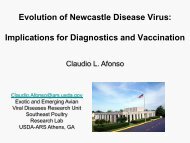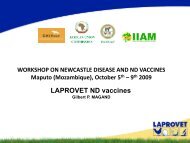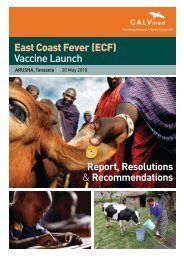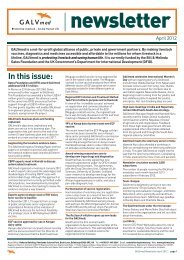A Path to Prosperity New Directions for African Livestock
GALVmed Impetus Strategy Paper
GALVmed Impetus Strategy Paper
- No tags were found...
You also want an ePaper? Increase the reach of your titles
YUMPU automatically turns print PDFs into web optimized ePapers that Google loves.
Box 6 Lessons Learnt from Unsuccessful Ef<strong>for</strong>ts <strong>to</strong> Introduce Feed Technologies<br />
<strong>to</strong> Small Farmers 100<br />
1 It is important <strong>to</strong> understand the social context in which small farmers operate.<br />
They tend <strong>to</strong> have very low risk thresholds. Even when farmers agree it is a good<br />
technology, they may not use it. Subsistence farmers have many other priority jobs<br />
apart from lives<strong>to</strong>ck husbandry. It is vital <strong>to</strong> realise that women commonly do more<br />
than 70% of lives<strong>to</strong>ck-based activities and they are usually already over-burdened,<br />
have little time <strong>to</strong> spare <strong>for</strong> extra work and may never have been consulted about<br />
the new technology.<br />
2 <strong>New</strong> technologies must be as simple and easy as possible. For example, when<br />
compounded cattle feed is introduced its uptake is normally fast (particularly<br />
<strong>for</strong> the dairy sec<strong>to</strong>r) as it requires no additional labour, there are clear delivery<br />
mechanisms and the availability of credit and the awareness of a quick economic<br />
return on the investment are relatively easy <strong>to</strong> realise.<br />
3 The quick economic return is vital. There must be a direct effect on income generation,<br />
competitiveness with other farm enterprises in terms of land use and labour. Market<br />
linkages or the value chain needs <strong>to</strong> be in place. The availability of a market <strong>for</strong> the<br />
animal products has facilitated the adoption of nutritional technologies.<br />
4 Understanding and developing partnerships is important. Business–farmer–scientist–<br />
extension worker interactions need <strong>to</strong> be strong and participa<strong>to</strong>ry. All these ac<strong>to</strong>rs<br />
have particular experience and understanding of how they interact, their working<br />
practices and the policy environment in which they operate. Understanding these<br />
interactions can help <strong>to</strong> remove bottlenecks <strong>to</strong> technology adoption.<br />
5 Institutional mechanisms need <strong>to</strong> be in position. This could be the capacity <strong>to</strong> provide<br />
extension services or model farms and certainly appropriate policies that provide<br />
incentives <strong>for</strong> key ac<strong>to</strong>rs in the value chain.<br />
6 The use of nutritional technologies at cooperative level (or farmers’ association level)<br />
enhances adoption of technologies.<br />
The Impetus Strategy Paper I Page 37











